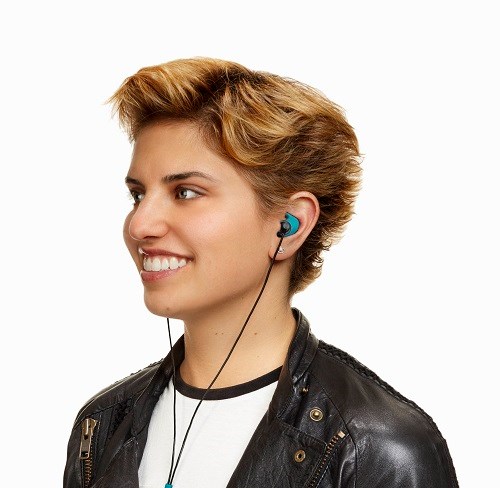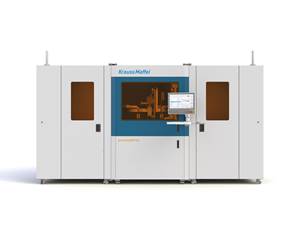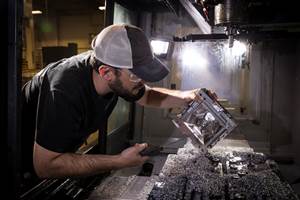Additive Manufacturing Is the New ‘Normal’
One of the first companies founded on the principle of individualized manufacturing puts AM to work right out front in its retail lobby.

Normal founder Nikki Kaufman, wearing her product.
Leaders of large and small businesses are constantly asking the question of how to attract young talent to careers in industry: How do we make manufacturing ‘cool’ again?
Nikki Kaufman has found an answer. Her brand-new company, which launched just last July, has a cool, intriguing name, Normal. It’s located in the hip, artsy Chelsea district of Manhattan’s West Side. Her company makes a product desired by almost any user of a smart phone or digital music player. And Normal makes the product better, faster, and cheaper than anyone else in the world by using the newest, “greenest,” and, some might say, coolest industrial technology—3D printing.
Kaufman, 29, started her company out of a quest for earphones that aren’t uncomfortable to wear for extended periods. She tried dozens of commercial earbuds without success and considered having a custom pair made. But she learned that would involve a visit to a doctor’s office, would take three to six weeks, and cost up to $2000. She decided she could do better on her own.
Last summer, Kaufman launched her brainchild based on the idea of making custom earbuds with a personalized fit in as little as 48 hr and for $199, including shipping and tax. And all you need is a free iTunes or Android app that walks you through steps of photographing your ears, choosing among several color options, and ordering the earphones.
And about her company’s name: “What is a normal ear shape? There’s no such thing. Everyone’s is different,” Kaufman explains. “Even your left and right ears can differ by up to 20%.”

Kaufman in front of two of her 10 Stratasts 3D printers.
Normal has joined the small handful of companies today (apart from service bureaus) whose business model is based on making proprietary products with additive manufacturing, or 3D printing as it’s commonly known. Standing in the store, you probably won’t immediately notice (this reporter didn’t) that you’re also in the factory area. Set flush into the walls are eight Fortus 250mc 3D printers from Stratasys, Ltd., Eden Prairie, Minn. There are two more of these printers on another floor, along with two Stratasys smoothing stations, two paint booths, two cleaning stations, and one laser cutter.
The 3D printers use the Fused Deposition Modeling (FDM) technology, which extrudes fine molten strands of thermoplastic—ABS, in this case—in thin layers according to a “sliced” CAD model of the part.
FDM is used to produce the earpiece that fits your ear cavity. Seven colors are available. It is soft-touch coated and assembled with a handful of purchased components, including an injection molded and UV-coated ABS/PC “inner cabinet,” the 14-mm audio speaker, CNC anodized aluminum “outer cabinet,” a brass tube, coaxial connector, and 360° rotating CNC anodized aluminum cable housing.
Normal has another use for FDM—to make tools like jigs and fixtures for its own internal manufacturing needs. That’s in line with what Stratasys CEO David Reis sees as the main near-term market opportunity for FDM—jigs, fixtures, and molds, also referred to as “augmented manufacturing”—rather than “direct digital manufacturing” (DDM) of end products, as Normal is doing.
(More details on Normal’s use of FDM will appear in a special supplement on Additive Manufacturing to accompany the February issues of Plastics Technology, MoldMaking Technology, and Modern Machine Shop magazines.)
Related Content
Large-Format “Cold” 3D Printing With Polypropylene and Polyethylene
Israeli startup Largix has developed a production solution that can 3D print PP and PE without melting them. Its first test? Custom tanks for chemical storage.
Read MoreKraussMaffei Launches Two Additive Manufacturing Lines at K 2022
Long established in injection molding, extrusion and polyurethane reaction process machinery, 184-yr-old KraussMaffei prepares to enter the industrial additive manufacturing market.
Read MoreHow Additive Manufacturing Can Help, not Hinder, Injection Moldability of New Designs
Four cost drivers—design for moldability, mold-base size, internal componentry, polish/custom finishing—dictate the financial and processing success of a molded part design. Learn how 3D printing can assist this process, while also understanding its potential pitfalls.
Read MoreFreeform Injection Molding Eases the Path to Medical Device Product Testing
A development and manufacturing service provider is using dissolvable molds to build injection molded silicone prototypes.
Read MoreRead Next
How Polymer Melts in Single-Screw Extruders
Understanding how polymer melts in a single-screw extruder could help you optimize your screw design to eliminate defect-causing solid polymer fragments.
Read MoreAdvanced Recycling: Beyond Pyrolysis
Consumer-product brand owners increasingly see advanced chemical recycling as a necessary complement to mechanical recycling if they are to meet ambitious goals for a circular economy in the next decade. Dozens of technology providers are developing new technologies to overcome the limitations of existing pyrolysis methods and to commercialize various alternative approaches to chemical recycling of plastics.
Read MorePeople 4.0 – How to Get Buy-In from Your Staff for Industry 4.0 Systems
Implementing a production monitoring system as the foundation of a ‘smart factory’ is about integrating people with new technology as much as it is about integrating machines and computers. Here are tips from a company that has gone through the process.
Read More


























